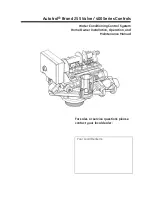
10
AQUA
JET pfn plus
The slits of the covers (1 and 10) are not bigger than 3mm. Stones and other objects not
bigger than those gaps, sucked in occasionally, do not damage the pump. If the pump is
operating in impure water, the impeller may get blocked and then the electronic system
will stop the pump that in consequence would need to be cleaned. Never use the pump
without a filter (parts 1, 10 and 11 or filter E according to fig. 2)! Connect appropriate
adapter to the pump outlet fitting the outlet adapter thread - internal or external pipe
thread R 1,5” or Rc 1,5” (PFN 10000 - R 1” or Rc 1”), then an appropriate hose, fountain head,
valve, distributor, etc. can be installed. In case of placing the pump outside of the tank
(fig. 2) the front cover should be removed.
/The way of removing the covers is described in detail in the next chapter “MAINTENANCE”./
The appropriate adapters (C and D) should be chosen for the pump intake and outlet.
Pump input thread is R 1,5” (PFN 10000 - R 1”) internal, while pump output thread is R
1,5” (PFN 10000 - R 1”) internal. The adapters (C and D) should be installed tightly with the
hoses connected to them.
CAUTION:
1. The hose must not be soft, as the powerful pump can deform it closing the flow.
2. A suction strainer (E) should necessarily be installed on the end of the intake hose that will
prevent sucking in of particles bigger than 5 mm.
The pump is not self priming, therefore when locating it as described above it should
be placed below the minimum water level according to figure. Before starting it fill the
intake and outlet hose with water.
The pump is started by connecting the plug to power socket. In case of locating the pump
outside of the water tank (fig. 2), the tightness of connections on the intake and outlet
should be verified and in case of such need repaired. The pump is designed for constant
operation. When operating submerged as well as when placing the pump outside of
the tank pay attention for the pump not to operate dry, without the water. The pump
is equipped with step-less regulation of operation efficiency with an external regulator.
Instruction on how to adjust it is illustrated on fig. 6.
MAINTENANCE
The pump does not require constant maintenance. If the pump operates in heavily pollut-
ed environment, with time the covers (1 and 10) or the intake strainer (E) can get clogged
considerably lowering the pump output.
To clean the covers (1 and 10), the pump should be disconnected from the power grid
– by pulling the plug out – then remove the pump from the water.
The way of removing the front cover (1) is shown on the figure 3. By pressing the cover
(1) on its sides according to arrows “I” it can be disconnected and tilted downwards ac-
cording to arrow “II”.
The way of removing the back cover (10) is shown on the figure 4. By pressing the cover
(10) in the center according to arrow “I” it can be disconnected and slightly tilted down-
wards according to arrow “II”. To completely remove the cover it should be pressed on the
bottom in two places according to arrows “III”. Together with the back cover the cord plug
(11) will be removed. It can be removed from the cover (10) and the cover can be taken
off the pump cord.
The removed elements can be cleaned under running water using a brush. The cleaned
covers can be installed in reverse order.
When installing the back cover (10) and the plug (11) figure 5 will be helpful. The way of
conduct:
a) the back cover (10) should be placed on the cord (K) of the pump;
b) the plug (11) should be pushed until resistance in the lower slit of the cover according
to the arrow paying attention to:
b1) the side bolts (H) of the plug (11) fit between the double projections (G) of the back
cover (10);
Содержание AQUAJET PFN 10000 PLUS
Страница 2: ...1 AQUAJET PFN PLUS 1 4 SCALE 1 8 11 3 6 7 9 4 5 2 10...
Страница 3: ...3 4 2 5 6...
Страница 27: ...27 10 11 5 10 b 11 b1 11 G 10 b2 J 10 c 10 11 L III 4 4 2 5 6 7 2 7 8 F 1 6 7 F 1 24...
Страница 52: ...52...
Страница 53: ...53...











































